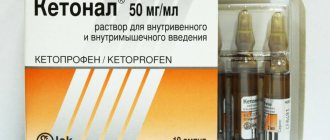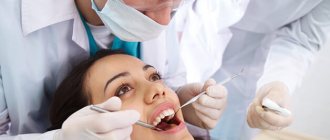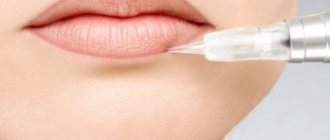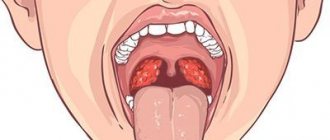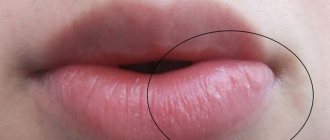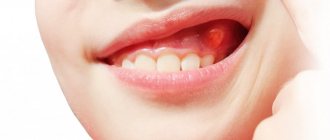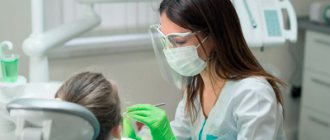Hair loss
It is normal to lose about 100 hairs per day. But if you notice large strands or clumps of hair on your pillow or in the shower, you may be low on iron. You are not alone. This is one of the most common nutritional deficiencies in the world. To check iron, the doctor may prescribe LVSS, Transferrin saturation with iron, Complete blood count (CBC/Diff) with leukocyte count without ESR, Reticulocyte count, Ferritin.
If you're a new mom and your hair is falling out like a waterfall, don't panic right away. During pregnancy, hair usually grows faster and thicker. After childbirth, estrogen and hair fall along with it. In a year everything should be back to normal. Iron deficiency after childbirth is quite common.
The most common lip problems are dryness, flaking and cracking. The reason for this is the structural features of the lips. As is known, they are divided into three parts: cutaneous, intermediate and mucous.
- the skin part has a structure similar to that of ordinary skin. It is covered with the epidermis, which is a stratified squamous keratinizing epithelium, and contains appendages - sebaceous, sweat glands and hair follicles with hair;
- the intermediate part - the red border of the lips, in everyday perception is called the lips, is also covered with a stratum corneum, which, however, is very quickly renewed and relatively “immature” cells rise to the surface. In addition, the red border of the lips does not contain skin appendages, but contains a large number of blood vessels and nerve endings;
- The mucous part occupies the posterior surface of the lips and is covered with stratified squamous non-keratinizing epithelium. Moistened with the secretion of the labial salivary glands.
It is precisely because of the rapid renewal of the stratum corneum, as well as the absence of sebaceous and sweat glands, that the skin of the red border of the lips has poor protective barriers, and therefore easily loses water and is sensitive to changes in environmental conditions.
The secretion of the sebaceous and sweat glands of the skin forms a hydrolipid mantle, which is the first line of defense of the skin, causing a pH gradient, which is necessary, among other things, for the normal functioning of enzymes in the stratum corneum and maintaining the functioning of a healthy microbiome, as well as a surface lipid barrier.
As for the rapid renewal of the stratum corneum of the red skin of the lips, such intensity of division does not allow the structures of the epidermis to “mature” normally. As a result, the horny scales and lipid layers of the stratum corneum do not form a sufficiently dense barrier; it remains more permeable than the barrier of normal skin. As a result, this causes accelerated water loss and dry skin. In addition, the latter provokes another problem - it is believed that trypsin- and chymotrypsin-like enzymes play a role in the degradation of desmosomes, the elements that ensure the adhesion of epidermal cells, and the water content in the stratum corneum is mentioned as a factor regulating the activity of these enzymes. Accordingly, with its deficiency, the enzymes do not work effectively enough and complete destruction of desmosomes does not occur - as a result, we observe peeling of the lips. It intensifies under the influence of various external factors - cold, wind, ultraviolet radiation, sharp temperature contrasts, dry air of rooms heated in winter, etc., since if the barrier functions of the skin are insufficient under these conditions, an even greater loss of water occurs and desquamation processes are further disrupted. In addition, against the background of dryness, cracks appear, which cause significant discomfort - as mentioned above, the skin of the lips is very actively innervated. In connection with the above, the main lip care products are considered to be balms containing occlusive components, i.e. those that prevent the evaporation of water from the skin.
Science-Based Lip Care
As you know, there are two fundamentally different ways to moisturize the stratum corneum. The first is to use a non-aqueous ointment based on petroleum jelly or silicone, which creates an occlusive layer on the skin to inhibit the evaporation of water: water accumulates in the stratum corneum and its level of hydration increases.
The second way is to bring water from outside with the help of preparations containing it. These can be gels (water + colloid) or emulsions (water + oil), which contain components that bind water (wetting agents). Moisturizing agents with low molecular weight (such as natural moisturizing factor components and ions) penetrate into the stratum corneum itself, accumulate there and attract water. High-molecular compounds (proteins, polysaccharides, glycols) remain on the surface of the skin and form a kind of wet compress.
The main ingredient in lip care products is most often Vaseline, which is considered one of the most powerful occlusive agents. However, it only retains moisture without restoring the natural barrier properties of the lips, on the contrary - due to the fact that Vaseline moisturizes too well, it can slow down the restoration of the epidermal barrier, the cells will not receive a signal in time that the barrier needs repair.
It is generally accepted that if barrier function cannot be restored (for example, in atopic dermatitis due to genetic defects), occlusive agents are necessary for permanent use. However, when you stop using them, everything usually returns to normal, some people even develop a kind of “dependence” on lip balms - if they apply them, relief comes, but as soon as they stop using these products, complaints about dryness and flaking return again. Therefore, if there is still a chance to restore barrier structures, occlusive agents should be used only at the initial stage.
And in the case of the barrier function of the lips, there is such a chance. And this is another way to increase skin hydration and restore its natural protective barrier. Recent studies have shown that in the lipid layers of the stratum corneum of the skin, the balance of ceramides is disturbed - one of the main (and most significant in quantity) components of the lipid barrier, along with cholesterol and free fatty acids (all these lipids are classified as so-called physiological lipids). Intercellular lipids of the stratum corneum hold the scales together (“cement”) and form the basis of the permeability barrier (lipid barrier), which prevents the diffusion of substances through the stratum corneum in both directions. A change in the ratio of lipids in the composition of the lipid barrier leads to disruption of its function.
It has been shown that in the stratum corneum of the red border of the lips, the amount of ceramides as such is generally reduced, while their imbalance is also observed - a higher percentage of such ceramide subtypes as CER [NS] (with short-chain CER [NS] dominating) and CER [AS ] and a lower percentage of CER [NP] and CER [NH] compared to other areas of the body skin.
In a recent study, Japanese scientists examined whether ceramides could reduce lip dryness and flaking as well as highly occlusive formulations. They used synthetic pseudoceramide (pCer, Cetyl PG hydroxyethyl palmitamide), which has already proven itself in the treatment of atopic dermatitis. Moreover, this pseudoceramide was included in the composition of the product that does not provide occlusion.
The study involved 31 healthy women (age range from 21 to 37 years; average age 28.6 years) with normal skin and complaints of dry lips. All women were divided into three groups according to the products used: control (a product without ceramides, which has moderate occlusive properties and confirmed its effect in one of the scientists' previous trials), a non-occlusive product with 0.5% pCer and with 2.0% pCer. Each sample was applied four times a day (morning, noon, evening, before bed) for 4 weeks. The degree of lip roughness, lip hydration, rate of transepidermal water loss (TEWL) and elasticity of the lip surface were assessed. Endogenous ceramide profiles and pCer absorption levels in the stratum corneum were also determined.
As a result, after 4 weeks in the group of women who used the drug 2.0% pCer, there was a significant decrease in roughness compared to the initial level, as well as with the drug with lower concentrations of ceramide and the control occlusive agent. Moreover, the improvement increased by the 4th week, at a time when by this time the effect of 0.5% of the drug had only appeared. Also, by week 4, the 2.0% pCer group showed a decrease in TEWL and an increase in lip hydration and elasticity. Interestingly, hydration and TEWL rates also improved in the control occlusive group by the second week, but then gradually decreased. A decrease in the amount of CER [NS] was also noted, an increased concentration of which is found not only on the lips, but also in atopic dermatitis, i.e. it is a marker of skin barrier failure. The amount of CER [NH], the low content of which has a high correlation with lip roughness, and CER [NP] also increased.
Regarding the absorption of pCer, it is quite natural that the higher its content, the better the absorption. However, since the amount of pCer absorbed at 2 weeks was much greater than at 4 weeks, this was also associated with increased lip roughness at first. By improving this parameter, absorption may stabilize.
What conclusions can be drawn from this information? For lip care, it is effective to use not just occlusive preparations that retain water, but to strengthen the natural barrier function of the lip skin with the help of physiological lipids - primarily in the form of ceramides. And the better the restoration of the lipid barrier, the less “dependence” you will have on classic Vaseline-based lip balms.
Sources:
Arai S., Oshida, K., Hikima, T. and Fukuda, Y. Study on lip surface-characteristics of stratum corneum and corneocytes on lip. J. Jap. Cosmet. Sci. Soc. 14, 66–70 (1990).
Arai, S., Oshida, K., Hikima, T. and Hasunuma, K. Study on lip surface-characteristics of chapped lip. J. Jap. Cosmet. Sci. Soc. 13, 64–68 (1989).
Hikima, R., Igarashi, S., Ikeda, N. et al. Development of lip treatment on the basis of desquamation mechanism. IFSCC Mag. 7, 3–10 (2004).
Ishikawa J., Shimotoyodome, Y., Ito, S., Miyauchi, Y., Fujimura, T., Kitahara, T., Hase, T. Variations in the ceramide profile in different seasons and regions of the body contribute to the stratum corneum functions. Arch. Dermatol. Res. 305, 151-162 (2013).
Shimotoyodome Y., Tsujimura, H., Ishikawa, J., Fujimura, T., Kitahara, T. Variations of ceramide profile in different regions of the body of Japanese females. J. Jap. Cosmet. Sci. Soc. 38(1), 3-8 (2014).
Imokawa G. A possible mechanism underlying the ceramide deficiency in atopic dermatitis: expression of a deacylase enzyme that cleaves the N-acyl linkage of sphingomyelin and glucosylceramide. J. Dermatol. Sci. 55, 1–9 (2009).
Tamura E., Yasumori H., Yamamoto T. The efficacy of a highly occlusive formulation for dry lips. Int J Cosmet Sci. 2020 Feb;42(1):46-52.
Tamura E., Ishikawa J., Yasuda Y., Yamamoto T. The efficacy of synthetic pseudo-ceramide for dry and rough lips. Int J Cosmet Sci. 2020 Nov 30.
Unexplained fatigue
This symptom fits almost any vitamin or mineral deficiency. It may be time to check your vitamin D levels. This vitamin is unique. It reduces the risk of cardiovascular disease, flu, multiple sclerosis, diabetes, colon, breast and prostate cancer. Plays an important role in regulating mood, sleep and wakefulness, and preventing depression. Increases calcium and phosphorus absorption and promotes bone mineralization. Vitamin D deficiency can cause muscle pain, weakness and unexplained fatigue.
WHY DO YOU NEED A 25-OH VITAMIN D TEST? Easy to measure. Just one 25-OH vitamin D test will show your current vitamin levels and supplemental needs. taking medications. Easy to pass. Add the 25-OH vitamin D test to your cart, sign up for delivery and receive a 50% discount by paying for your order online. Easy to adjust. Enter your 25-OH Vitamin D test results into our free calculator. We will calculate your dosage of vitamin D medications and offer you a convenient dosage regimen.
Vitamins B9 and B12 help the body produce red blood cells and chemicals that regulate sleep patterns and mood. When you don't get enough of them, you may feel forgetful, weak, and apathetic.
How to remove cracked lips with nutrition
Since we are talking about obvious symptoms of vitamin deficiency, it is important to think about correcting your diet. First of all, you should avoid eating:
- fast food;
- sweets;
- alcoholic drinks;
- smoked meats;
- strong coffee and tea.
If there is a lack of vitamin A, the diet includes cod liver, beef, goose meat, carrots, pumpkin and spinach. The lack of vitamin E can be compensated with the help of pine nuts, sunflower seeds, sea buckthorn, olive oil, almonds, and broccoli.
If there is not enough vitamin B2, the diet should be enriched with dairy products and whole grains, cheeses, beef liver, and dark green vegetables. Vitamin C contains sardines, soybeans, liver, rolled oats, rice, cod. B12 contains by-products - such as beef and pork liver, rabbit meat, hard cheeses, sour milk products and fish. As for vitamin C, its deficiency can be compensated for by eating citrus fruits, porcini mushrooms, currants, bell peppers (sweet varieties), herbs and kiwi.
What is vitamin E
This is a family of tocopherols and tocotrienols - eight antioxidants that protect body cells from free radicals. This is the name given to oxygen atoms that are missing one electron. They strive to take it away from everything they reach, damaging surrounding cells and causing their death. Vitamin E absorbs free radicals, reducing the harmful effects of solar radiation and improving antitumor protection.
Getting into skin cells, it reduces the synthesis of prostaglandins and nitrogen oxides - mediators of inflammation. Its wound healing properties are known. Therefore, vitamin E is used to treat inflammatory skin diseases - psoriasis, atopic dermatitis, ulcers and pustular dermatosis. The anti-inflammatory effectiveness of tocopherol for acne has been proven. A study on mice showed that tocopherol prevented skin cancer, but this did not work in humans.
The magical effects of vitamin E are the result of taking it orally. When used externally, it does not treat wounds, burns and scars - this is what the study showed. But in combination with retinol, phytonadione and vitamin C, it sometimes helps remove circles under the eyes. It is often added to anti-aging creams, but it is not yet clear whether it will help protect skin from aging. But it is known that in some people the external use of this vitamin causes an adverse reaction in the form of contact dermatitis.

